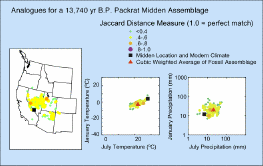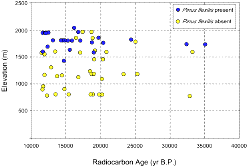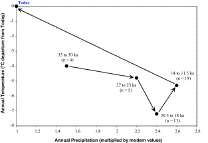

ANALOGUE-BASED PALEOCLIMATIC RECONSTRUCTIONS
Modern Analogues for Pleistocene Vegetation and Climatic Differences from Today.
Using the method described above, the fossil data from packrat middens were compared to our North American grid to locate the best modern analogues for the late Pleistocene vegetation. Figure 4
 Figure 4. (click to enlarge)
|
We estimated the modern temperature and precipitation at each packrat midden site using the same techniques we used to assign climatic values to our North American grid points (Thompson and others, 1999). "Anomalies" for each climatic parameter at each site were then calculated by taking the difference between the estimated modern climatic parameters at the packrat collection site and the late Pleistocene estimates.
RECONSTRUCTION OF LATE PLEISTOCENE CLIMATES
Reconstructed Climates Through Time. The proposed site of the nuclear waste repository at approximately 5000 ft (1524 m) elevation at Yucca Mountain was apparently at or near the lower elevational limits of Pinus flexilis (Figure 5), indicating that relatively moist forest environments did not extend below this elevation during the last ~40,000 years. However, climate did vary through the late Pleistocene, and to quantify these changes we analyzed suites of packrat midden assemblages grouped by the
 Figure 5. (click to enlarge)
|
Reconstructed Climates Versus Elevation. Maps of the reconstructed climate reveal differences in the size of the anomalies (difference between modern and reconstructed past climate parameters) within short distances, apparently due to the influence of the high physiographic relief of southern Nevada. For the LGM, there are very strong relationships between elevation and the amplitude of the temperature difference from today (r2 = 0.97 for January, 0.96 for July, and 0.98 for annual temperature). There are weaker, but still strong relations for precipitation anomalies versus elevation (r2 = 0.51 for January, 0.82 for July, and 0.88 for annual precipitation) for the late glacial period (14 to 11.5 ka). These paleoclimatic reconstructions imply that during the late Pleistocene the gradients of decreasing temperature and increasing precipitation with rising elevation were more gradual than those of today in southern Nevada. Subsequent analyses of packrat midden assemblages from farther south in the Mojave Desert to as far north as the Bonneville basin indicate that these apparent shallower-than-modern relations between increasing elevation with decreasing temperature and increasing precipitation occurred during the LGM throughout this region.
 Figure 6. (click to enlarge)
|
Paleoclimatic Inferences from Missing Plant Species During the Late Pleistocene. As discussed above, the late Pleistocene occurrences of limber pine (Pinus flexilis), Utah juniper (Juniperus osteosperma), and other montane and steppe plants in modern desert environments suggest cooler than modern temperatures, and greater moisture availability than today (Spaulding, 1985). Spruce (Picea engelmannii, P. pungens), lodgepole pine (Pinus contorta), subalpine fir (Abies lasiocarpa), prostrate juniper (Juniperus communis) and other boreal plants have not been found in packrat middens in southern Nevada, suggesting that the late Pleistocene climate was not cold or wet enough for these boreal plants. On the other hand, Pleistocene-age middens from the Yucca Mountain area lack evidence of ponderosa pine (Pinus ponderosa), Douglas-fir (Pseudotsuga menziesii), and other montane trees that live today in the mountains of southern Nevada. Their absence, and the rarity of single-needle pinyon pine (Pinus monophylla), may suggest that Pleistocene climates were too cold for those plants. Similarly, the absence of the now widespread creosote bush (Larrea divaricata) suggests that late Pleistocene temperatures were much colder than those of today (Spaulding, 1985). In this section we address the question: do our paleoclimatic estimates (if correct) provide an adequate explanation for the absence of these forest and desert plants?
The present-day climatic and plant distributional data in Thompson and others (1999) provide the basis for examining the apparent climatic meaning of the late Pleistocene absences of key plant species in the Yucca Mountain Region. As illustrated in Figure 7, our reconstructed LGM January temperatures were apparently too cold for the survival of Larrea divaricata (in accordance with Spaulding's [1985] interpretation) or Juniperus californica. Conversely, winter temperatures were apparently too warm for Picea pungens, Picea engelmannii, Abies lasiocarpa, Juniperus communis, and Pinus flexilis (which, as illustrated in Figure 5, was apparently near its lower elevational limits here during the LGM). The subsequent figures provide similar illustrations of the reconstructed climates compared with the apparent tolerances of these species in respect to July and annual temperature (Figures 8 and 9), and to January, July, and annual precipitation (Figures 10 to 12). These figures collectively indicate that many of the 'absent' taxa presently live under climatic conditions that differ in at least one aspect of seasonal or annual temperature or precipitation from the analogue-based reconstruction of the LGM climate.
Table 3 summarizes the overall patterns observed in these figures, and as seen here, both temperature and precipitation were important in excluding many of these taxa. However, the reasons for the exclusions of Pinus edulis, Pinus longaeva, and Pinus monophylla are unclear. On the other hand, all three of these species lived in or near southern Nevada during parts of the late Pleistocene, so it is not surprising that the reconstructed climates would apparently permit their growth near Yucca Mountain.
|
|
|
TEMPERATURE |
|
|
PRECIPITATION |
|
|---|---|---|---|---|---|---|
|
|
January |
July |
Annual |
January |
July |
Annual |
|
*Abies concolor |
|
|
|
|
|
D |
|
Abies lasiocarpa |
H |
H |
H |
|
D |
D |
|
Abies magnifica |
|
|
|
D |
|
D |
|
Juniperus californica |
C |
M |
C |
M |
W |
|
|
Juniperus communis |
H |
H |
H |
|
D |
M |
|
^Juniperus scopulorum |
|
|
|
|
M |
M |
|
Larrea divaricata |
C |
C |
C |
|
|
|
|
Picea engelmannii |
H |
H |
H |
D |
M |
D |
|
Picea pungens |
H |
H |
H |
|
D |
D |
|
Pinus albicaulis |
H |
H |
H |
D |
M |
D |
|
Pinus contorta |
|
H |
H |
|
D |
D |
|
Pinus edulis |
|
|
|
|
|
|
|
*Pinus flexilis |
H |
H |
H |
|
|
D |
|
^Pinus longaeva |
|
|
|
|
|
|
|
*Pinus monophylla |
|
|
|
|
|
|
|
Pinus ponderosa |
|
|
|
|
|
D |
|
*Pseudotsuga menziesii |
|
M |
|
|
|
D |
|
Tsuga heterophylla |
|
H |
|
D |
|
D |
|
Tsuga mertensiana |
|
H |
M |
D |
D |
D |
|
|
|
|
|
|
|
|
|
|
|
|
|
|
|
|
|
KEY: |
|
|
|
|
|
|
|
H = too hot for species, C = too cold, D = too dry, W = too wet, M = marginal |
||||||
|
* = present near Yucca Mountain during part of the late Pleistocene |
||||||
|
^ = present regionally during the late Pleistocene |
||||||
|
|
|
|
|
|
|
|
|
|
|
TEMPERATURE |
|
|
PRECIPITATION |
|
|
|
January |
July |
Annual |
January |
July |
Annual |
|
Reason for exclusion: |
|
|
|
|
|
|
|
too warm or dry |
6 |
10 |
8 |
6 |
8 |
14 |
|
too cold or wet |
2 |
1 |
2 |
1 |
1 |
0 |
|
Plants for whom reason of exclusion unclear: Pinus edulis, Pinus longaeva, Pinus monophylla |
||||||
|
NEXT: Evaluation of Climatic Anomalies for the LGM |
| AccessibilityFOIAPrivacyPolicies and Notices | |
| |
|